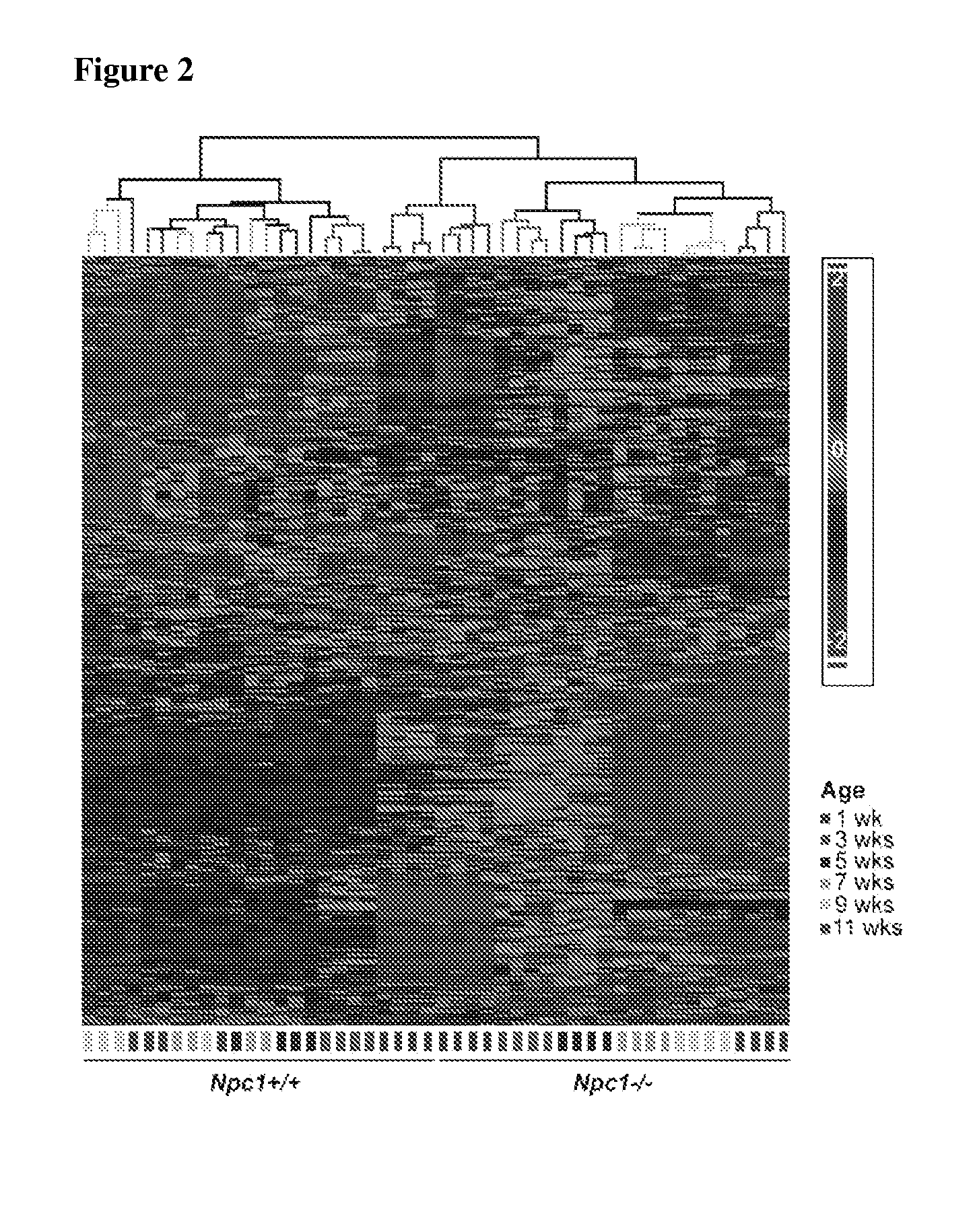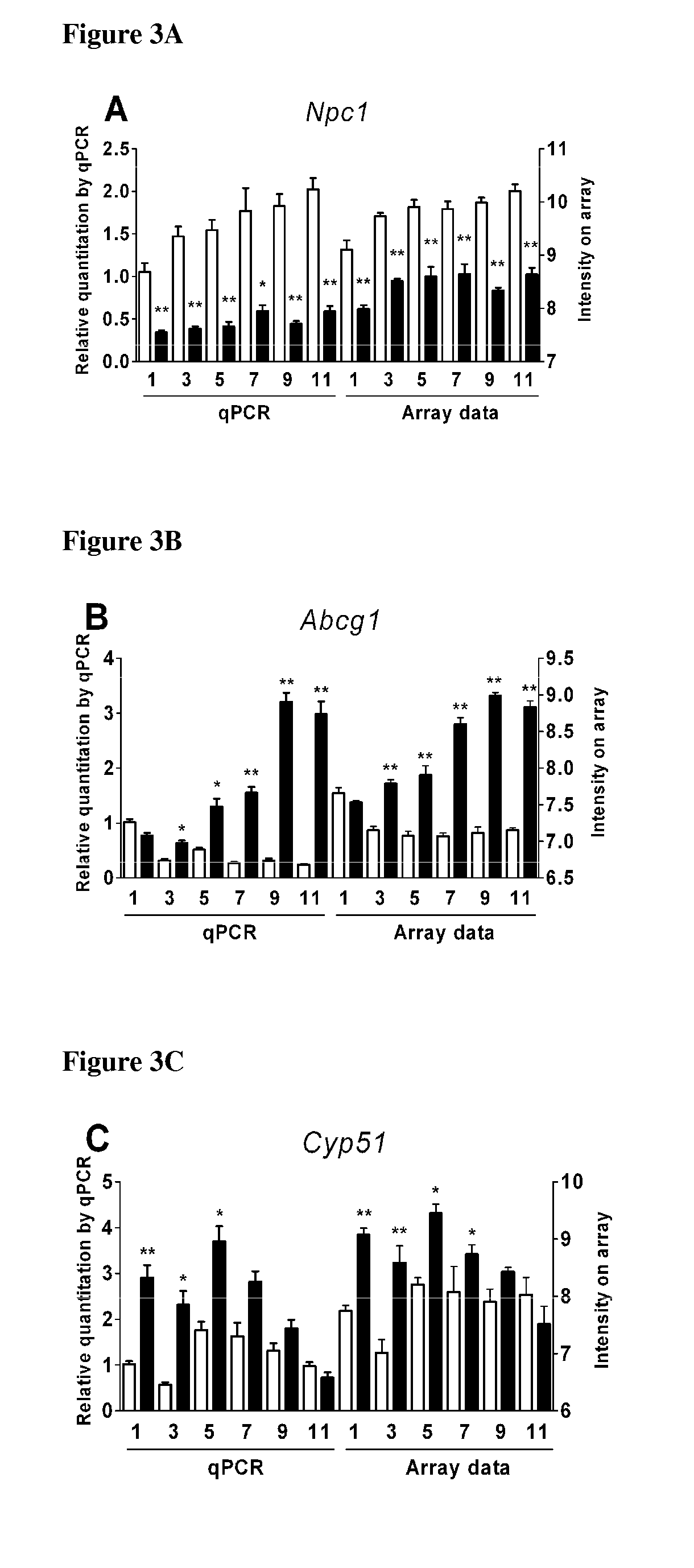Identification of two novel biomarkers for niemann-pick disease type c
- Summary
- Abstract
- Description
- Claims
- Application Information
AI Technical Summary
Benefits of technology
Problems solved by technology
Method used
Image
Examples
example 1
Identification and Validation of Differentially Expressed Genes
[0112]To identify differentially expressed genes occurring in Npc1− / − liver tissue, microarray analysis was performed using cDNA isolated from female control (Npc1+ / +) or mutant (Npc1− / −) mice, of one, three, five, seven, nine, and eleven weeks of age. Principal component analysis (PCA) identified three distinct expression groups: 1) one-week-old control and mutant mice, 2) three- to eleven-week-old Npc1− / − mice, and 3) three- to eleven-week-old control mice (FIG. 1). This delineation of specific groups demonstrates that differential gene expression in Npc1 mutant mice occurs by three weeks of age, prior to onset of symptoms.
[0113]To identify differentially expressed genes (DEG), the array results from control and mutant mice at each age were compared. Selection criteria were based on combined P-value (P≦0.05) and fold-change (FC ≦−1.3 or FC ≧1.3). Although it varied based on the specific age, in general a slightly highe...
example 2
[0118]To gain insight into pathological processes, the DEG data were used to identify pathways with significantly altered gene expression. MetaCore software was used to identify GeneGo pathway maps containing genes with a modified expression.
TABLE 3List of all significantly modified pathways (FDR step-up value≦0.05). The numberof DEG at each age figure in the table, with the number of upregulated DEG betweenparenthesis, and compared to the total number of genes in the GeneGo pathway map. Thetotal number of modified pathways is indicated at the end of each category, with the numberof pathways containing more than 75% of upregulated DEG between brackets.1 week3 weeks5 weeks7 weeks9 weeks11 weeksMetabolismArachidonic acid production12(8) / 50Atherosclerosis_Role of ZNF202 in regulation of6(4) / 216(6) / 217(6) / 2111(6) / 2111(6) / 21expression of genes involved in atherosclerosisButanoate metabolism7(2) / 6523(2) / 65Cholesterol biosynthesis17(16) / 8815(15) / 88Leucine, isoleucine and va...
example 3
Genes with Consistent Differential Expression
[0126]A subset of 150 genes was identified that demonstrated altered expression at all six ages (Table 4).
TABLE 4List of the 150 differentially expressed genes in 1-, 3-, 5-, 7-, 9-, and 11-week-oldNpc1− / − mice compared to their control littermates. p-values and fold-changes (FC) areindicated at each age.Gene1 week3 weeks5 weeks7 weeks9 weeks11 weeksSymbolGene descriptionp-valueFCp-valueFCp-valueFCp-valueFCp-valueFCp-valueFCCholesterol and lipid homeostasisNpc1Niemann-Pick disease type3.018E−08−2.1642.986E−09−2.3254.785E−10−2.4612.765E−09−2.3311.929E−13−3.1371.238E−12−2.959C1Npc2Niemann-Pick disease type2.042E−051.4591.144E−031.3221.021E−061.5603.841E−091.7561.344E−061.5511.670E−091.786C2Plin3Perilipin 3, or mannose-6-phosphate9.253E−081.6387.720E−081.6442.061E−132.1468.146E−091.7231.962E−142.2571.035E−142.288receptor (MPR) binding protein 1,or MPR tail-interacting protein 47 kDaApoa4Apolipoprotein A-IV3.138E−092.4246.638E−122.9612.507E−0...
PUM
| Property | Measurement | Unit |
|---|---|---|
| Acidity | aaaaa | aaaaa |
| Level | aaaaa | aaaaa |
Abstract
Description
Claims
Application Information
 Login to View More
Login to View More - R&D
- Intellectual Property
- Life Sciences
- Materials
- Tech Scout
- Unparalleled Data Quality
- Higher Quality Content
- 60% Fewer Hallucinations
Browse by: Latest US Patents, China's latest patents, Technical Efficacy Thesaurus, Application Domain, Technology Topic, Popular Technical Reports.
© 2025 PatSnap. All rights reserved.Legal|Privacy policy|Modern Slavery Act Transparency Statement|Sitemap|About US| Contact US: help@patsnap.com



